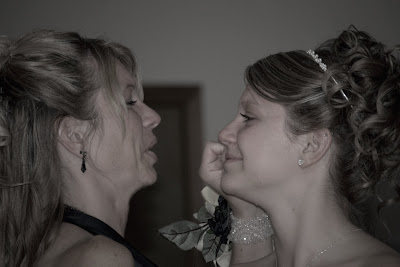I took Thursday off of work and we spent the day in Hollywood. We visited Grauman's Chinese theatre (where you find the hand and foot prints of the famous in the sidewalk out front), we walked Hollywood Boulevard to see all the stars, and had lunch at the Disney Soda Fountain next to El Capitan theatre. We also visited the new Madame Tussaud's Wax Museum. It was a blast, and honestly the figures are very lifelike. You are allowed to touch them, and they encourage lots of pictures. It's the closest I've come to spotting a star since I got here...
Sunday, September 27, 2009
Tammy's California Adventure
Well, the blog has veered into the political lately, and I think it's time to get back to talking about what we've been up to. The big news around here, besides all the babies this year, is that my mom came for a visit! Tammy hasn't ever flown before, and my dad's illness kept them from making the trip to Massachusetts while I was getting my PhD. So she had her first plane ride, and her first vacation since before my dad was diagnosed with cancer. He passed away two years ago, and so it was really past time for her to have some fun. And I hope she did have a good time, because I know Jason and I really enjoyed her visit. She flew in on Monday afternoon and we spent that day making lasagna together and going to the mall. On Tuesday we headed down to the Santa Monica Pier and more shopping at the 3rd Street Promenade. This is my mom at the entrance to the Pier: You may notice the diet soda in her hand. She was absolutely appalled when she got to my house and found out that all we have to drink is water, and the only snacks we have are fruit and vegetables with some granola bars. She tried to make herself some sweet tea, but we didn't even have granulated sugar in the house. I guess we've really embraced the healthy lifestyle more than I realized! She was so happy to get to buy a soda. She was a good sport about taking the bus and walking everywhere too!
You may notice the diet soda in her hand. She was absolutely appalled when she got to my house and found out that all we have to drink is water, and the only snacks we have are fruit and vegetables with some granola bars. She tried to make herself some sweet tea, but we didn't even have granulated sugar in the house. I guess we've really embraced the healthy lifestyle more than I realized! She was so happy to get to buy a soda. She was a good sport about taking the bus and walking everywhere too!
I took Thursday off of work and we spent the day in Hollywood. We visited Grauman's Chinese theatre (where you find the hand and foot prints of the famous in the sidewalk out front), we walked Hollywood Boulevard to see all the stars, and had lunch at the Disney Soda Fountain next to El Capitan theatre. We also visited the new Madame Tussaud's Wax Museum. It was a blast, and honestly the figures are very lifelike. You are allowed to touch them, and they encourage lots of pictures. It's the closest I've come to spotting a star since I got here...
 But Friday was the day my mom had been waiting for. Universal Studios. We were there when they opened, and we stayed till they closed. We rode pretty much everything in the park and took the studio tour. My mom wasn't crazy about the Simpson's ride, but she loved the Mummy. Here's my mom and I at the entrance:
But Friday was the day my mom had been waiting for. Universal Studios. We were there when they opened, and we stayed till they closed. We rode pretty much everything in the park and took the studio tour. My mom wasn't crazy about the Simpson's ride, but she loved the Mummy. Here's my mom and I at the entrance:
 We had a blast. Saturday was her last full day here as she flew out early Sunday morning, and we spent the entire day at Long Beach. Unfortunately, Jay's memory card for the Nikon D300 pooped out on us, and we have no pictures! I can tell you we did the Ghosts and Legends tour at the Queen Mary, and visited the Aquarium of the Pacific. We had dinner at Parker's Lighthouse where we saw a sea lion playing in the waves. It's really a shame about the pictures, because it was a lovely evening. And a great visit! My mom is an old pro at flying now, and we both hope to see her again soon.
We had a blast. Saturday was her last full day here as she flew out early Sunday morning, and we spent the entire day at Long Beach. Unfortunately, Jay's memory card for the Nikon D300 pooped out on us, and we have no pictures! I can tell you we did the Ghosts and Legends tour at the Queen Mary, and visited the Aquarium of the Pacific. We had dinner at Parker's Lighthouse where we saw a sea lion playing in the waves. It's really a shame about the pictures, because it was a lovely evening. And a great visit! My mom is an old pro at flying now, and we both hope to see her again soon.
I took Thursday off of work and we spent the day in Hollywood. We visited Grauman's Chinese theatre (where you find the hand and foot prints of the famous in the sidewalk out front), we walked Hollywood Boulevard to see all the stars, and had lunch at the Disney Soda Fountain next to El Capitan theatre. We also visited the new Madame Tussaud's Wax Museum. It was a blast, and honestly the figures are very lifelike. You are allowed to touch them, and they encourage lots of pictures. It's the closest I've come to spotting a star since I got here...
Tuesday, September 15, 2009
Good-bye Patrick Swayze
When I was 11 years old, the movie Dirty Dancing was released. I didn't see it until I was 12, when my aunt gave me a video cassette tape of the movie. My mom didn't speak to my aunt for months after that; she complained that all I did that summer was watch Dirty Dancing. And I did. Every single day, I watched Dirty Dancing, practiced the steps, and wished I could dance that well. That was probably when I realized how much I enjoy dancing, and it's only been for short periods since then that I haven't been taking some form of dance class. I also developed an enormous crush on Patrick Swayze. I still love the movie, the music, the dancing, and I still have a crush on Patrick Swayze. Not because he's handsome and moves like magic, but because over time I think he showed himself to embody a lot of the ideals I held for a person. He was married to his wife, Lisa, for over 30 years. He seemed modest and idealistic, doing films he wanted to do because he liked them, not necessarily because he was trying to be the biggest movie star in Hollywood. He did the work because that was what he loved to do. I also admired how strong he stayed throughout his fight with cancer. I admired him, and I feel for his wife and mother, and I'm so sad that I've lost my first crush. I think Jay will be getting lots of extra love today, because I'm so grateful we've still got our 30 years ahead of us.
Sunday, September 13, 2009
Photos from Jess & Tom's Wedding
So it's been nearly two months since Jess and Tom's wedding, and I have just now uploaded some of the photos that I took. How does that happen? Anyhow, here they are.
For those of you expecting prints and a DVD, it's in the mail. Seriously, it is. No, really!
Jess and Tom exchange vows
Jess with her Dad walking down for wedding photos
Jess with her Mom
Fun with Cake
The new bride & groom with Dad
So the wedding was a great time, and even though it means that Jess is now in Germany for a few years, we wish them both the very best. Starting a life together is tough, a lot of work, but the most rewarding thing you could ever do.
See you two in Germany next year!
-jh
For those of you expecting prints and a DVD, it's in the mail. Seriously, it is. No, really!
 |
| From Jess & Tom Wedding |
 |
 |
| From Jess & Tom Wedding |
 |
| From Jess & Tom Wedding |
 |
| From Jess & Tom Wedding |
So the wedding was a great time, and even though it means that Jess is now in Germany for a few years, we wish them both the very best. Starting a life together is tough, a lot of work, but the most rewarding thing you could ever do.
See you two in Germany next year!
-jh
Friday, September 4, 2009
Health care reform
I am someone who is lucky enough to have insurance. Despite this, insurance often refuses to pay for routine or necessary medical care, and I have to pay out of pocket. My husband has had to go without insurance, because we could not afford to pay private premiums. We had to hope that he didn't get hurt. My father's insurance was canceled as soon as he was diagnosed with cancer. My mother's insurance covered him briefly, then she was fired because she had to take time off work to care for him. Without the help of Emory University, we could not have paid for his care. In spite of this, my parents lost their home and could barely afford to pay their bills because of the overwhelming debt that ensued. THEY WERE BOTH EMPLOYED WITH INSURANCE COVERAGE WHEN HE WAS DIAGNOSED. My sister and her children cannot get health coverage. And I have had many friends who have been refused insurance because of "pre-existing conditions." As someone who has worked intimately inside the medical industry, while many doctors and nurses are very caring and do want to do the best they can for their patients, they often have to fight the insurance companies themselves to do what they know needs to be done. I have seen single-payer health care in action in Canada on many visits I have made, and IT WORKS. I am not afraid to pay more in taxes to get our country out of debt and provide assistance to those who need it. Our health system is broken, and badly. Why have the best doctors in the world, when none of us can afford to see them? For me, this a very personal issue. I believe that health care reform is critical for this country.
-April Shiflett
8 ways reform provides security and stability to those with or without coverage
health-insurance-consumer-protections/
8 common myths about health insurance reform
http://www.WhiteHouse.gov/realitycheck
http://www.WhiteHouse.gov/realitycheck/faq
8 Reasons We Need Health Insurance Reform Now
-April Shiflett
8 ways reform provides security and stability to those with or without coverage
- Ends Discrimination for Pre-Existing Conditions: Insurance companies will be prohibited from refusing you coverage because of your medical history.
- Ends Exorbitant Out-of-Pocket Expenses, Deductibles or Co-Pays: Insurance companies will have to abide by yearly caps on how much they can charge for out-of-pocket expenses.
- Ends Cost-Sharing for Preventive Care: Insurance companies must fully cover, without charge, regular checkups and tests that help you prevent illness, such as mammograms or eye and foot exams for diabetics.
- Ends Dropping of Coverage for Seriously Ill: Insurance companies will be prohibited from dropping or watering down insurance coverage for those who become seriously ill.
- Ends Gender Discrimination: Insurance companies will be prohibited from charging you more because of your gender.
- Ends Annual or Lifetime Caps on Coverage: Insurance companies will be prevented from placing annual or lifetime caps on the coverage you receive.
- Extends Coverage for Young Adults: Children would continue to be eligible for family coverage through the age of 26.
- Guarantees Insurance Renewal: Insurance companies will be required to renew any policy as long as the policyholder pays their premium in full. Insurance companies won't be allowed to refuse renewal because someone became sick.
8 common myths about health insurance reform
- Reform will stop "rationing" - not increase it: It’s a myth that reform will mean a "government takeover" of health care or lead to "rationing." To the contrary, reform will forbid many forms of rationing that are currently being used by insurance companies.
- We can’t afford reform: It's the status quo we can't afford. It’s a myth that reform will bust the budget. To the contrary, the President has identified ways to pay for the vast majority of the up-front costs by cutting waste, fraud, and abuse within existing government health programs; ending big subsidies to insurance companies; and increasing efficiency with such steps as coordinating care and streamlining paperwork. In the long term, reform can help bring down costs that will otherwise lead to a fiscal crisis.
- Reform would encourage "euthanasia": It does not. It’s a malicious myth that reform would encourage or even require euthanasia for seniors. For seniors who want to consult with their family and physicians about end-of life decisions, reform will help to cover these voluntary, private consultations for those who want help with these personal and difficult family decisions.
- Vets' health care is safe and sound: It’s a myth that health insurance reform will affect veterans' access to the care they get now. To the contrary, the President's budget significantly expands coverage under the VA, extending care to 500,000 more veterans who were previously excluded. The VA Healthcare system will continue to be available for all eligible veterans.
- Reform will benefit small business - not burden it: It’s a myth that health insurance reform will hurt small businesses. To the contrary, reform will ease the burdens on small businesses, provide tax credits to help them pay for employee coverage and help level the playing field with big firms who pay much less to cover their employees on average.
- Your Medicare is safe, and stronger with reform: It’s myth that Health Insurance Reform would be financed by cutting Medicare benefits. To the contrary, reform will improve the long-term financial health of Medicare, ensure better coordination, eliminate waste and unnecessary subsidies to insurance companies, and help to close the Medicare "doughnut" hole to make prescription drugs more affordable for seniors.
- You can keep your own insurance: It’s myth that reform will force you out of your current insurance plan or force you to change doctors. To the contrary, reform will expand your choices, not eliminate them.
- No, government will not do anything with your bank account: It is an absurd myth that government will be in charge of your bank accounts. Health insurance reform will simplify administration, making it easier and more convenient for you to pay bills in a method that you choose. Just like paying a phone bill or a utility bill, you can pay by traditional check, or by a direct electronic payment. And forms will be standardized so they will be easier to understand. The choice is up to you – and the same rules of privacy will apply as they do for all other electronic payments that people make.
http://www.WhiteHouse.gov/
http://www.WhiteHouse.gov/
8 Reasons We Need Health Insurance Reform Now
- Coverage Denied to Millions: A recent national survey estimated that 12.6 million non-elderly adults – 36 percent of those who tried to purchase health insurance directly from an insurance company in the individual insurance market – were in fact discriminated against because of a pre-existing condition in the previous three years or dropped from coverage when they became seriously ill. Learn more: http://www.healthreform.gov/
reports/denied_coverage/index. html - Less Care for More Costs: With each passing year, Americans are paying more for health care coverage. Employer-sponsored health insurance premiums have nearly doubled since 2000, a rate three times faster than wages. In 2008, the average premium for a family plan purchased through an employer was $12,680, nearly the annual earnings of a full-time minimum wage job. Americans pay more than ever for health insurance, but get less coverage. Learn more: http://www.healthreform.gov/
reports/hiddencosts/index.html - Roadblocks to Care for Women: Women’s reproductive health requires more regular contact with health care providers, including yearly pap smears, mammograms, and obstetric care. Women are also more likely to report fair or poor health than men (9.5% versus 9.0%). While rates of chronic conditions such as diabetes and high blood pressure are similar to men, women are twice as likely to suffer from headaches and are more likely to experience joint, back or neck pain. These chronic conditions often require regular and frequent treatment and follow-up care. Learn more: http://www.healthreform.gov/
reports/women/index.html - Hard Times in the Heartland: Throughout rural America, there are nearly 50 million people who face challenges in accessing health care. The past several decades have consistently shown higher rates of poverty, mortality, uninsurance, and limited access to a primary health care provider in rural areas. With the recent economic downturn, there is potential for an increase in many of the health disparities and access concerns that are already elevated in rural communities. Learn more: http://www.healthreform.gov/
reports/hardtimes - Small Businesses Struggle to Provide Health Coverage: Nearly one-third of the uninsured – 13 million people – are employees of firms with less than 100 workers. From 2000 to 2007, the proportion of non-elderly Americans covered by employer-based health insurance fell from 66% to 61%. Much of this decline stems from small business. The percentage of small businesses offering coverage dropped from 68% to 59%, while large firms held stable at 99%. About a third of such workers in firms with fewer than 50 employees obtain insurance through a spouse. Learn more: http://www.healthreform.gov/
reports/helpbottomline - The Tragedies are Personal: Half of all personal bankruptcies are at least partly the result of medical expenses. The typical elderly couple may have to save nearly $300,000 to pay for health costs not covered by Medicare alone. Learn more: http://www.healthreform.gov/
reports/inaction - Diminishing Access to Care: From 2000 to 2007, the proportion of non-elderly Americans covered by employer-based health insurance fell from 66% to 61%. An estimated 87 million people - one in every three Americans under the age of 65 - were uninsured at some point in 2007 and 2008. More than 80% of the uninsured are in working families. Learn more: http://www.healthreform.gov/
reports/inaction/diminishing/ index.html - The Trends are Troubling: Without reform, health care costs will continue to skyrocket unabated, putting unbearable strain on families, businesses, and state and federal government budgets. Perhaps the most visible sign of the need for health care reform is the 46 million Americans currently without health insurance - projections suggest that this number will rise to about 72 million in 2040 in the absence of reform. Learn more: http://www.WhiteHouse.gov/
assets/documents/CEA_Health_ Care_Report.pdf
Subscribe to:
Posts (Atom)